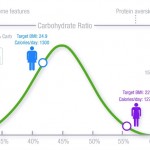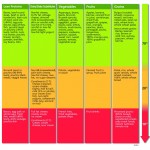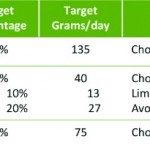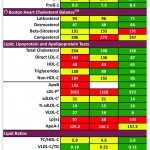By Gary Tufel
This is an online-only companion article to the CLP June feature, “Personalized Medicine Progresses.”
“There’s no such thing as a sudden heart attack,” says Susan Hertzberg, president and CEO of Boston Heart Diagnostics Corp. “There’s a lot of money being spent after a catastrophic event has happened for stents, bypass surgery, and other care (estimated costs are $50,000 per year for 20 years), but comparatively very little on assessing true risk or prevention before the emergency room visit,” she says.
Genetics play a role in both cardiovascular disease (CVD) and diabetes, but these diseases are mostly preventable and reversible, says Hertzberg. Lifestyle choices are the primary drivers. “Unfortunately, it’s not as simple as saying, ‘Take this statin.’ Statins are effective. The problem is that 30% of patients don’t ever fill their prescriptions, and of those who do, more than 50% stop taking their medications in the first year.”

Figure 1. From Boston Heart Diagnostics, a personalized food plate based on recommended dietary targets. Adapted from the USDA Center for Nutrition Policy and Promotion’s ChooseMyPlate.gov website.
Many patients experience muscle pain as a result of taking statins, and 2% to 3% are completely statin-intolerant due to variants on a specific gene. Boston Heart has a molecular test to identify these people in advance, so caregivers can prescribe an appropriate therapy that treats the problem and increases likelihood of compliance, Hertzberg says.
Boston Heart’s mission is to provide actionable test results to patients and support them in changing behaviors. Hertzberg calls the process a “giant virtual hug.” Testing falls in four broad categories—lipids, metabolics (diabetes), inflammation, and genetics—addressing all the critical metrics for assessing and managing a patient’s specific CVD risk.

Table 1. Boston Heart Diagnostics guides patients with color-coded food options, making it easier to select the right foods.
“We also help clinicians engage and educate patients,” Hertzberg says. Boston Heart explains what the results mean using imagery, metaphor, and color-coded graphics in an easy-to-understand report that it provides to clinicians to share with patients (green-highlighted test results are good, yellow are alerts, and red are bad). It includes recommendations for appropriate drug therapies based on the patient’s test results and health history, as well as a tailored plan for nutrition and lifestyle changes.

Table 2. Boston Heart Diagnostics provides patients with recommended dietary targets based on their test results and food preferences.
The company’s registered nutritionists factor in personal food preferences in designing recommendations that patients can stick to, and they are available by phone for coaching and support. “If a person is a vegetarian, it’s not helpful to tell them they can lose weight with the Atkins diet,” Hertzberg explains. “We look for beneficial food choices that the patients might already be including in their diets, but perhaps in the wrong proportion.”
Boston Heart uses graphics for easy interpretation, for example, showing a segmented dinner plate instructing patients to eat a certain food 70% of the time, another 20%, and a third 10% (see Figure 1; Table 1; Table 2).

Table 3. Boston Heart Diagnostics provides a patient progress report; subsequent test results move from red to yellow to green, providing long-term motivation.
This contrasts sharply with the situation of most patients who never see their test results, or just get a bunch of numbers that they don’t know how to interpret. The goal of Boston Heart’s report is to empower patients to take control of their own health. Hertzberg says this is critical now that labs will be required to provide test results directly to patients if requested as part of Obamacare. Many physicians and labs opposed this when it was first proposed, she says, but Boston Heart favored the move, calling the old way “paternalistic” (see Table 3).
“Fear is a powerful motivator at first when you see a bad test result, but it doesn’t last,” says Hertzberg. “People get numb, so you have to move from fear to positive reinforcement. When subsequent test results move from red to yellow to green, that provides long-term motivation.”
Gary Tufel is a contributing writer for CLP. For further information, contact chief editor Steve Halasey via [email protected].






